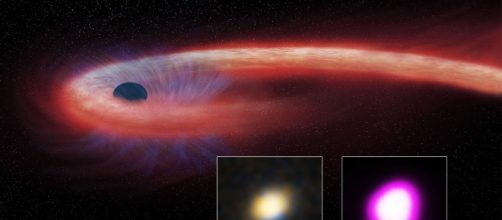A supermassive black hole pulled apart a star and then ingested its remains for ten years. This marks the first time that the swallowing of a star is known to last for a decade. Previous tidal disruption events (TDEs) around a black hole have been recorded but none has persisted so bright for too long as his astronomical event, suggesting that this event could have been the most massive star to be destroyed. The observation was made using NASA´s Chandra X-ray observatory, Swift satellite and ESA´s XMM-Newton orbiting observatory.
Tidal disruption event
This is an event that occurs when a star gets close enough to a supermassive black hole´s event horizon. This proximity causes the intense black hole´s gravity to destroy the star, sending some of the stellar remains outward at very high speeds, while the rest is swallowed by the black hole. The infalling star remains heat up to several millions of degrees and produces a distinctive X-ray burst. Although several tidal disruption events have been detected since the 1090´s, the ripping apart of this star has taken ten times (ten years) longer than any previous one.
XJ1500+0154
The black hole from which the X-ray source was detected is located in a galaxy that is located at approximately 1.8 billion light years away from the earth.
Using Chandra X-ray observatory, it was revealed that the black hole is located at the center of its host galaxy. The X-ray data also showed that this giant body´s surrounding radiation has exceeded the Eddington limit, where the force of pressure from the hot gas acting outward and the force of gravity acting inward are in balance.
X-ray brightness of XJ1500+054 will fade over the next decade
The discovery of this event where supermassive black holes can grow through TDEs and probably other means at rates above the Eddington limit may help explain the process by which supermassive black holes were able to attain masses of billions of times greater than the sun when the universe was merely a billion years old. Scientists think that as this black hole s star debris supply reduces in the next decade, so the X-ray brightness of XJ1500+054 will dwindle.

